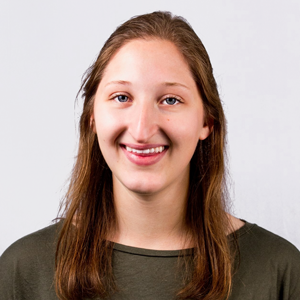This post is the first in an ongoing series of stories about our personal relationships with mathematics. We introduced this series in a recent post. Today’s math story is from Allison Hamburger, a member of the Desmos engineering team.
My math story is all about counting.
As a computer science major in college, I developed the habit of noting the exact number of people I perceived as women in a classroom. Perhaps unsurprisingly, in my math and computer science classes, there were often only a handful, sometimes even in a large lecture hall. In classes further outside of my major, that wasn’t the case.
The counting began casually but became a more consistent part of entering a room as I learned more about gender dynamics. I was early in understanding my identity as a cisgender woman, and noting where I was often a minority seemed to help me see those dynamics more clearly.
But way before that, I had to learn long division.
In third grade, I was one of two girls in the class’s advanced math group. When my teacher introduced long division to the group, it became clear that the boys in the class already knew how to do it. They had all gone to a separate math tutoring center together and learned long division there.
As the boys showed off their skills in the classroom, my confidence plummeted. Clearly, I thought, there was no place for me in this group.
My mom told me, “They learned it. You’ll learn it too.”
And it was true. I spent some individual time with my teacher to get up to speed. I learned the procedure and have more or less been successfully dividing numbers ever since.
There are many possible variations of this experience of being excluded, and they are so often faced by members of other underrepresented groups. It’s quite realistic that I could have been dissuaded from math entirely, as similar stories have done for others.
I feel lucky that my math story continued. My mom’s encouragement was unwavering, and my dad eagerly shared his own love of numbers and patterns with me. My mom and I talked puzzles, and my dad and I memorized digits of pi together. And in the years that followed, I was supported by several memorable teachers.
There was an elementary teacher who brought in newspaper clippings to tie the Supreme Court justice selection process to math. There was an algebra teacher who brought such humor and delight to the classroom that I couldn’t help but feel excited to go to class. And there was a high school teacher who convinced me that Math Club was cool by introducing me to advanced math topics outside of the curriculum and spreading his contagious enthusiasm for contest puzzle problems. I made it out of high school with some net positive feelings towards math … at least, enough to study computer science in college and to start a career in software engineering.
Although it didn’t stop me from feeling like a “math person” in the long run, the moment in third-grade math sticks with me.
At the time, I was meeting the expectations of my math group and my teacher, but the circumstances told me quite clearly that I didn’t have the skills my classmates had. I already felt like an outsider as one of the only girls, and here I was, given very specific evidence that I wasn’t supposed to be in that group. That I didn’t belong.
As a child, I brushed it off and mostly forgot about this experience, but looking back, I now see this as the very clear beginning of a thread inherent in my relationship with math. I thought that it was in college that I started counting the women in the room, but really, the habit began way back at age eight.
Even though I had an affinity for math early on, it took a whole lot of intentional support to keep me here. And it still takes intentional support to keep me here because math stories don’t end when we leave school. When I have moments of uncertainty about whether this field is really for me, the underlying feeling is that same one of wondering if I’m behind. It’s that same feeling of being one of the only third-grade girls in the room.
We want to tell math stories for a lot of reasons. I’m sharing mine because I don’t think I’m the only one who has felt inclined to count the number of others like themself in a math classroom.
